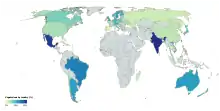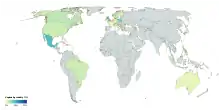Anexo:Vegetarianismo por país
El vegetarianismo y el veganismo son prácticas dietarias que varían entre los diferentes países. Estas diferencias radican en relación a las leyes y la idiosincrasia religiosa y cultural de los países. Países como la India, tienen una fuerte tradición vegetariana vinculada con la religión hinduista. En Europa, este tipo de alimentación está relacionado con el auge de los temas relacionados con el ecologismo, derechos de los animales, protección ambiental y cuidados de la salud. En el Reino Unido las leyes de etiquetado de los alimentos permiten una fácil identificación de aquellos productos aptos para vegetarianos.[1]

Buddhist influenced Korean vegetarian side dishes.
Demografía

Número de vegetarianos por país

Número de veganos por país
Estimación porcentual en base a datos crudos
| País | Dieta vegetariana (%)[2] | Número aproximado de individuos | Año | Dieta vegana (%) | Número aproximado de individuos | Año | Nota |
|---|---|---|---|---|---|---|---|
| 12 | 5,400,000 | 2020[3] | |||||
| 12.1 | 2,500,000 | 2020[4] | Plantilla:Percentage | 2019[5] | |||
| 10 | 880,000 | 2018[6] | |||||
| 0 | pad=yes}} | 800,000 | 2018[7] | Plantilla:Percentage | 110,000 | 2018[8] | ||
| 14 | 29,260,000 | 2018[9] | Plantilla:Percentage[10] | 6,330,660 | 2018[9][10] | Vegan percentage derived from vegan and vegetarian respondents only,[10] due to access bias, and calculated on top of IBOPE's survey[9] | |
| 9.4 | 3,411,000 | 2016[11] | Plantilla:Percentage | 835,000 | 2016[11] | ||
| 6 | 1,500,000 | 2018[12] | |||||
| 4 – 5 | 50,000,000 – 70,000,000 | 2013[13] 2014[14] | |||||
| 5 |500,000 |2019[15] | Plantilla:Percentage | 100,000 | 2019[15] | ||||
| 2.5 | 140,000 | 2019[16] | |||||
| 4.2 | 230,000 | 2018[17] | Plantilla:Percentage | 100,000 | 2018[17] | ||
| 5.2 | 3,400,000 | 2019[18] | Plantilla:Percentage | 726,000 | 2019[18] | ||
| 10 | 8,000,000 | 2018[19] | Plantilla:Percentage | 1,300,000 | 2018[19] | ||
| 2 | 200,000 | 2019 | Plantilla:Percentage | 80,000 | 2019[20] | ||
| Plantilla:Percentage – Plantilla:Percentage | 375,000,000 | 2012[21] 2014[22] 2014[23] 2018[24] | |||||
| 4.3 – 8.4 | 153,500 | 2018[25][26] | Plantilla:Percentage – Plantilla:Percentage | 146,500 | 2018[25][27] | ||
| 13 | 1,046,000 | 2015[28][29] | Plantilla:Percentage | 421,000 | 2014[28][29] | ||
| pad=yes}} | 5,340,000 | 2020[30] | Plantilla:Percentage | 1,326,600 | 2020[30] | ||
| Plantilla:Percentage | 280,000 | 2015[31] | La mayoría de los vegetarianos son Rastafari | ||||
| 9 | 11,160,000 | 2019[32] | Plantilla:Percentage | 3,500,000 | 2016[33] | ||
| 3 | 60,000 | 2017[34] | |||||
| 19 -20 [cita requerida] | 25,000,000 | 2018[35] 2016[36] | Plantilla:Percentage[cita requerida] | 2016[36] | |||
| 850,000 |
2020[37] |
Plantilla:Percentage | 150,000 | 2020[38] |
|||
| Plantilla:Percentage | 500,000 | 2019[39] | |||||
| Plantilla:Percentage | 150,000 | 2019[40] | Plantilla:Percentage | 50,000 | 2019[41] | ||
| Plantilla:Percentage | 5,000,000 | 2014[42] | Plantilla:Percentage | 2,000,000 | 2014 | ||
| Plantilla:Percentage | 3,072,000 | 2016[43] | Plantilla:Percentage[cita requerida] | 2,688,000 | 2016[43] | Survey conducted by marketing research firm Mintel. No rough data or method shown; these statistics are based on a report Plant Powered Perspectives which is not publicly available | |
| Plantilla:Percentage | 120,000 | 2017[44] | Plantilla:Percentage | 60,000 | 2018[45] | Survey conducted by marketing research firm Nielsen Holdings | |
| Plantilla:Percentage – Plantilla:Percentage | 4,380,000 – 5,840,000 | 2014[46][47] | |||||
| Plantilla:Percentage – Plantilla:Percentage | 28,922 – 33,054 | 2007/2008[48] | Plantilla:Percentage – Plantilla:Percentage | 6,197 – 10,329 | 2007/2008[48] | Age group: 18–65; a representative sample; unbiased data (survey conducted by National Institute of Public Health); new data will be available soon (2018/2019/2020). | |
| Plantilla:Percentage | 1,500,000 | 2017[49] | |||||
| 1.5 | 697,000 | 2017[50] | Plantilla:Percentage | 93,000 | 2017[50] | Adult population | |
| Plantilla:Percentage | 969,000 | 2014[51] | Plantilla:Percentage | 388,000 | 2014 | Based on a 1000-person telephone survey. | |
| Plantilla:Percentage | 1,176,156 | 2017[52] | Plantilla:Percentage | 252,033 | 2017[52] | ||
| Plantilla:Percentage – Plantilla:Percentage | 3,297,011 | ||||||
| Plantilla:Percentage | 2,300,000 | ||||||
| 5.2 | 2,000,000 | 2017[57] | |||||
| Plantilla:Percentage | 9,950,000 | 2019[58] | Plantilla:Percentage | 2,920,000 | 2019[58] | ||
| 5 | 16,000,000 | 2018[59] | Plantilla:Percentage | 7,588,000 | 2018[60] | ||
| 10 | 9,000,000 | 2011[61] |
Véase también
Referencias
- «Guidance on vegetarian and vegan labelling». UK Government Food Standards Agency. Consultado el 29 December 2008.
- Includes pescetarians
- «¿Cuántos Veganos y vegetarianos hay en Argentina?». elmilenio.info. 5 November 2020. Consultado el 11 December 2020.
- «Surge in Aussies eating vegetarian continues». animalsaustralia.org. October 2020. Consultado el 2 de mayo de 2021.
- «Vegans a 1 per cent minority in a country of meat eaters, survey finds». abc.net.au. 25 October 2019. Consultado el 2 de mayo de 2021.
- «Umfrage: Zehn Prozent vegan oder vegetarisch». Consultado el 23 July 2020.
- «Bijna helft van de Belgen eet minder vlees dan een jaar geleden». DeMorgen.be (en neerlandés). Consultado el 22 March 2019.
- «Share of vegans and vegetarians in Belgium in 2018, by region». statista.com. February 2018. Consultado el 3 April 2021.
- «IBOPE 2018: Pesquisa do IBOPE aponta crescimento histórico no número de vegetarianos no Brasil». IBOPE/Sociedade Brasileira Vegetariana. May 2018. Consultado el 1 de mayo de 2018.
- «Mapa Veg – Censo Vegetariano e Vegano Brasileiro: Estatísticas». Mapa Veg (en portugués de Brasil). Consultado el 23 de mayo de 2018.
- Charlebois, Sylvain; McCormick, Maggie; Juhasz, Mark (2016). «Meat consumption and higher prices». British Food Journal (Emerald Group Publishing Limited) 118 (9): 2251-2270. doi:10.1108/bfj-03-2016-0121.
- «Un 6% de la población chilena es vegetariana». eldesconcierto.cl. 2 de mayo de 2018. Consultado el 2 de mayo de 2019.
- https://timesofindia.indiatimes.com/world/china/Chinas-vegetarian-population-touches-50-million-Report/articleshow/29725767.cms
- «Bezmasou stravu preferuje desetina mladých». Ipsos (en cs-cz). 19 April 2019. Consultado el 1 February 2021.
- «STATISTIK OM VEGETARISK LEVEVIS I DANMARK». vegetarisk.dk. 5 September 2020. Consultado el 5 September 2020.
- Jallinoja, Piia. «What do surveys reveal about the popularity of vegetarian diets in Finland?». versuslehti.fi. Consultado el 14 July 2020.
- «Combien de végétariens en France ?». porcmag.com (en francés). 4 November 2019. Consultado el 28 January 2021.
- «Anzahl der Veganer und Vegetarier in Deutschland». Vebu.de. Consultado el 8 April 2018.
- «"Go Vegan": 80.000 άτομα ασπάζονται τη διατροφή στην Ελλάδα». protothema.gr. Consultado el 6 March 2019.
- https://www.thehindu.com/todays-paper/the-food-habits-of-a-nation/article3089973.ece
- «Sample Registration System Baseline Survey 2014 (table 5.1)». Census Govt. India. Consultado el 10 April 2014.
- Shridhar, Krithiga; Dhillon, Preet Kaur; Bowen, Liza; Kinra, Sanjay; Bharathi, Ankalmadugu Venkatsubbareddy; Prabhakaran, Dorairaj; Reddy, Kolli Srinath; Ebrahim, Shah (4 June 2014). «Nutritional profile of Indian vegetarian diets – the Indian Migration Study (IMS)». Nutrition Journal 13: 55. PMC 4055802. PMID 24899080. doi:10.1186/1475-2891-13-55.
- https://www.bbc.com/news/world-asia-india-43581122
- https://www.thejournal.ie/ireland-vegetarians-vegans-2-4058390-Jun2018/
- «Bord Bia report dietary lifestyles». bordbia.ie. Consultado el 10 de abril de 2020.
- «Bord Bia report dietary lifestyles». bordbia.ie. Consultado el 10 de abril de 2020.
- «In the land of milk and honey, Israelis turn vegan». Reuters.com. 21 July 2015. Consultado el 23 January 2018.
- טלשיר, רחל (17 September 2014). הארץ (en hebreo) https://www.haaretz.co.il/food/eatornot/.premium-1.2436863
|url=sin título (ayuda). Consultado el 23 July 2017. Parámetro desconocido|script-title=ignorado (ayuda) - «Eurispes 2020, aumentano i vegani: mai un dato così alto». vegolosi.it (en italiano). 30 January 2020. Consultado el 11 December 2020.
- «3 of the Best Countries for Vegetarians». thedailymeal.com. 21 October 2015. Consultado el 24 April 2019.
- «Vegetarians in Japan». f-navigation.net. 10 October 2019. Consultado el 29 January 2021.
- «日本と世界のヴィーガン率・ベジタリアン率» (en japonés). 9 February 2016. Consultado el 29 January 2021.
- «Aptauja: Veģetāriešu īpatsvars Latvijā samazinājies līdz zemākajam līmenim šajā tūkstošgadē». diena.lv (en latvian). 29 October 2017. Consultado el 31 January 2021.
- «Women Are Leading the Growing Vegan Movement in Mexico». LiveKindly.co. 17 August 2018. Consultado el 21 April 2019.
- https://www.statista.com/statistics/859529/mexico-share-vegetarians-flexitarians-vegans/
- «Hoeveel vegetariërs zijn er?». vegetariers.nl (en neerlandés). Consultado el 13 December 2020.
- «Hoeveel veganisten zijn er?». veganisme.org (en neerlandés). Consultado el 13 December 2020.
- «The rise of vegetarians: 1 in 10 New Zealanders mostly, or completely, meat-free». stuff.co.nz. 12 February 2019. Consultado el 2 de mayo de 2021.
- «Unge drømmer om grønnsaker, men digger kjøtt». Oslo Metropolitan University. 15 January 2019. Consultado el 4 April 2021.
- «Unge drømmer om grønnsaker, men digger kjøtt». Oslo Metropolitan University. 15 January 2019. Consultado el 4 April 2021.
- «Vegan communities growing, along with research on health benefits». The Manilla Times. 8 July 2014. Consultado el 24 April 2019.
- «Mintel: Diety roślinne jednym z wiodących światowych trendów 2017 roku». PortalSpozywczy.pl. Consultado el 7 July 2018.; based on «Power to the Plants: the rise of plant-based eating». mintel.com. Consultado el 7 March 2020.
- «120 000 vegetarianos – Número quadruplica em 10 anos». Centrovegetariano.org. Consultado el 23 January 2018.
- «Number of vegetarians in Portugal rises by 400 percent in 10 years». Theportugalnews.com. Consultado el 9 June 2018.
- «ФОМ: "Кто такие вегетарианцы?"».
- «Superjob.ru: "Более 10% населения мира – вегетарианцы. Как Вы относитесь к этой системе питания?"».
- Gabrijelčič Blenkuš (2009). Prehrambene navade odraslih prebivalcev Slovenije z vidika varovanja zdravja (en esloveno). Ljubljana, Slovenia: Inštitut za varovanje zdravja Republike Slovenije. pp. 118-119. ISBN 978-961-253-042-6.
- «[Weekender] Korea turns corner on going meat-free». The Korea Herald. 16 June 2017. Consultado el 24 April 2019.
- «Photographic image» (JPG). Lantern.es. Archivado desde el original el 25 June 2017. Consultado el 23 January 2018.
- «One in ten Swedes is vegetarian or vegan, according to study». The Independent. 24 March 2014. Consultado el 25 April 2019.
- «Veggie survey 2017». Swissveg.ch. Consultado el 23 January 2018. Uso incorrecto de la plantilla enlace roto (enlace roto disponible en Internet Archive; véase el historial, la primera versión y la última).
- «From radical to trendy for Mainers living without meat». Pressherlad.com. 14 January 2015. Consultado el 23 January 2018.
- «The New Vegan Movement in Taiwan». Ketagalanmedia.com. 20 June 2016. Consultado el 23 January 2018.
- «Countries with the Highest Rates of Vegetarianism». Worldatlas.com. Consultado el 23 January 2018.
- https://topics.amcham.com.tw/2019/01/meatless-dining-for-religion-or-lifestyle/
- «Vegetarian? Try out these places in Kyiv». Kyiv Post. 8 March 2018. Consultado el 24 April 2019.
- «UK: dietary habits 2019». Statista (en inglés). December 2019. Consultado el 13 de junio de 2021.
- Inc., Gallup. «Snapshot: Few Americans Vegetarian or Vegan». Gallup.com. Consultado el 4 August 2018.
- Inc., Gallup. «Snapshot: Few Americans Vegetarian or Vegan». Gallup.com. Consultado el 4 August 2018.
- «ĂN CHAY – XU HƯỚNG MỚI CỦA LỐI SỐNG HIỆN ĐẠI (PHẦN 1)». nhipcauthegioi.hu (en vietnamita). 26 January 2011. Consultado el 2 de mayo de 2019.
Este artículo ha sido escrito por Wikipedia. El texto está disponible bajo la licencia Creative Commons - Atribución - CompartirIgual. Pueden aplicarse cláusulas adicionales a los archivos multimedia.
